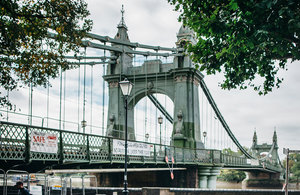Operation Brock – a series of measures that improve Kent’s resilience in the event of disruption to services across the English Channel – will be deployed overnight on Sunday 27 December, with the contraflow active from Monday 28 December, in preparation for the end of the EU Transition Period on 31 December 2020.
A significant part of Operation Brock is keeping the M20 open in both directions by using a contraflow road layout on the M20 London-bound carriageway between junctions 8 and 9 (from Maidstone to Ashford) and directing lorries heading for mainland Europe onto the coastbound carriageway, where they can be queued if necessary.
To make sure the contraflow is deployed safely, the M20 will be closed overnight in both directions between junctions 8 and 9 on the nights of 27 and 28 December.
Traffic volumes permitting, the M20 will close at 10pm on 27 December with both carriageways set to reopen by 10am on 28 December, or earlier if possible. These times have been chosen to minimise disruption to road users and avoid the key Christmas travel period. The M20 will also be closed overnight on 28 December between 10pm and 10am.
Once the barrier is in place, the road will reopen in its new configuration, with HGVs and other freight heading for the Port of Dover or Eurotunnel using the coastbound carriageway on the M20, where it will be queued if necessary. All other traffic – including local freight – should follow the signs and cross over to enter the contraflow on the M20 London bound carriageway. Drivers should look out for signs directing them to either stay on the coastbound carriageway or to enter the contraflow. All cars and motorbikes should enter the contraflow.
Highways England south east operations director Nicola Bell said:
The live test last weekend went really well with the contraflow system operating as expected. It gave us and our Kent Resilience Forum partners a valuable insight into timings for deployment and was a very successful exercise. The test also gave the DVSA the opportunity to test their plans.
The two moveable barrier machines worked exceptionally well with over 14,000 tonnes of concrete blocks being moved in just a few hours, together with more than 8,000 cones.
Head of Kent Resilience Team Mark Rolfe said:
To help keep the county moving, the Kent Resilience Forum has brought together Department for Transport, Highways England, Kent Police, and Kent County Council to agree a single plan to minimise the impact of any cross-Channel disruption.
Ensuring the M20 moveable barrier is in place ahead of Transition Day is part of this plan and our joint commitment to keep Kent’s transport network running safely and providing reliable travel information.
About Operation Brock
Operation Brock is a series of measures which crucially keeps the M20 open in both directions using a contraflow system. As with previous deployments in 2019, Operation Brock has stages that can be deployed sequentially, scaling up or down to meet demand. When Operation Brock is in force it is a legal requirement to use the signed routes only for HGV journeys to Port of Dover and Eurotunnel. Depending on the scale of disruption, and whether HGVs are travelling to Port of Dover or Eurotunnel, they will be directed to a holding site. Failure to comply with instructions may result in fines and further delays. Kent Police take decisions on when to use the different phases of the system. Options include:
- A20 Dover TAP: A queuing system which holds lorries until space becomes available at the Port
- M20 Moveable Barrier: A concrete barrier than can be deployed quickly between junctions 8 and 9 of the M20 to install a contraflow. HGVs bound for Dover and/or Eurotunnel will be held on the coastbound carriageway
- Manston Airfield: an off-road site designed to hold traffic heading for the Port of Dover. Border readiness checks will take place here to ensure hauliers have the correct paperwork
- Ashford Sevington Inland Border Facility: an off-road site next to junction 10A of the M20, likely to be used if the M20 contraflow approaches capacity
For more information on Operation Brock and other contingency measures in Kent, visit:
General enquiries
Members of the public should contact the Highways England customer contact centre on 0300 123 5000.
Journalists should contact the Highways England press office on 0844 693 1448 and use the menu to speak to the most appropriate press officer.
